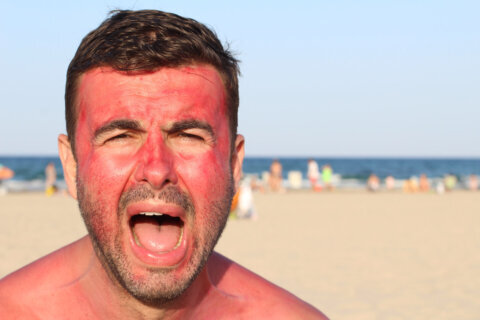Many people realize they’re exposed to more of the sun’s ultraviolet rays when they go to the beach, a lake or a pool because the water and sand reflect sunlight onto the skin. This creates indirect exposure to UV rays, in addition to the direct exposure you get from the sun beating down on your skin. You also may know that UV exposure is greater in the mountains where the air is thinner and the sun’s rays are more intense. This is all true, and it’s a call for extra protection for your skin.
But it’s a mistake to overlook less well-known factors that can increase your skin’s exposure and/or sensitivity to the sun’s harmful rays. Certain medications, foods, skin care products and other agents can cause photosensitivity, a chemically-induced change in the skin that makes it unusually sensitive to sunlight. Think of it this way: The agents that create photosensitivity contain chemicals that are “like gunpowder, and UV radiation is the match that causes the reaction to happen,” explains Dr. Bruce Robinson, a dermatologist in New York City. “When UV light hits that chemical, it causes a reaction like an explosion in the skin, and you get damage.”
These reactions include phototoxicity, which occurs when UV rays interact with a substance in a drug or food you’ve ingested or a cream you’ve applied, resulting in a bad sunburn, sometimes with blistering and damage to areas exposed to direct sunlight. This reaction usually occurs within hours of sun exposure, Robinson says, and over time it can increase the risk of skin cancer and premature aging.
[See: 7 Ways to Prevent Skin Cancer.]
By contrast, with photoallergy, exposure to UV rays changes a substance from the drug, food or product “into something new so the body recognizes it as foreign and activates the immune system,” says Dr. Barbara Reed, a clinical professor of dermatology at the University of Colorado Hospital and a dermatologist in private practice in Denver. “Photoallergy does not occur with a first exposure to a drug, but develops over time. It can take a few days to show up and is usually more like an itchy rash than an exaggerated sunburn.”
People with certain autoimmune diseases (like lupus) or acquired conditions like polymorphic light eruptions (an itchy rash that occurs with sun exposure in those who have developed a sun sensitivity) are most susceptible to photosensitivity. But anyone who ingests or uses the following substances is at risk:
Drugs: Certain antifungal drugs, antihistamines (including diphenhydramine, or Benadryl), oral contraceptives, non-steroidal anti-inflammatory drugs ( NSAIDs like ibuprofen, ketoprofen and naproxen), antibiotics (including “sulfa” drugs, quinolones and tetracyclines), oral diabetes drugs (sulfonylureas), diuretics and tricyclic antidepressants can cause photosensitivity. The same is true of the herbal remedy St. John’s wort, which is taken for depression, anxiety and PMS.
Foods: Consuming celery, dill, fennel, figs, lime, parsley and wild carrots can increase sun sensitivity.
Perfumes and essential oils: Applying scents like bergamot, bitter orange, lavender, lemon verbena, musk, rosemary or sandalwood can make your skin more reactive to the sun.
Skin care products: Check for ingredients such as alpha-hydroxy acids (AHAs like glycolic acid), beta-hydroxy acids (BHAs like salicylic acid) and tretinoins (like Retin-A). Each of these agents strips the outer layer of the skin, the stratum corneum, which makes the skin more sensitive to the sun. “This layer gives some protection against ultraviolet radiation, so when it is gone, the skin is more sensitive to the sun,” Reed says. Plus, the chemical benzoyl peroxide, which is in many over-the-counter acne products, can cause photosensitivity.
[See: 7 Surprising Things That Age You.]
Keep in mind: Photosensitivity reactions aren’t universal. In other words, not everyone who takes a certain drug or uses a particular product will experience photosensitivity, notes Dr. D’Anne Kleinsmith, a dermatologist in private practice in West Bloomfield, Michigan. And even if you do have a photosensitive reaction on one occasion, that doesn’t guarantee that you will again or every time you use or ingest that substance.
Nevertheless, if you use or consume any photosensitizing ingredients, “you should try to do outdoor activities in the early morning or the late afternoon,” Kleinsmith says. Also, take extra precautions before spending time in the sun: Choose a water-resistant sunscreen that protects against the sun’s UVA and UVB rays (look for the words “broad spectrum”). “Creams and lotions work better than sprays,” Kleinsmith notes. Apply a sunscreen with SPF 30 every day (SPF 50 to 70 if you’re going to the beach or golfing), 20 to 30 minutes before you go outside — and reapply it every 1 1/2 to two hours while you’re outdoors. Most people don’t put on enough sunscreen, experts say, so apply more than you think you need to.
Also, wear sun-protective clothing and wide-brimmed hats, and try to avoid sun exposure between 11 a.m. and 3 p.m. when the sun’s rays are strongest, advises Dr. Erin Gilbert, a dermatologist in New York City.
[See: Your Guide to Stylish Sun Protection.]
If you’re going to the beach and you’re sun-sensitive, Kleinsmith recommends taking Heliocare in the morning. This oral supplement contains an extract of Polypodium leucotomos, a tropical fern that’s rich in antioxidant compounds that protect the skin from free radical damage. “It’s another adjunctive treatment in the skin-protection program,” Kleinsmith says. It’s a smart move to increase your odds of preventing a painful sunburn or unexpected skin damage from ruining your summer fun.
More from U.S. News
Could Your Summer Blues Be Seasonal Depression?
Summer Workouts: How to Handle the Heat
Your Guide to Stylish Sun Protection
Surprising Things That Can Increase Sun Sensitivity originally appeared on usnews.com







